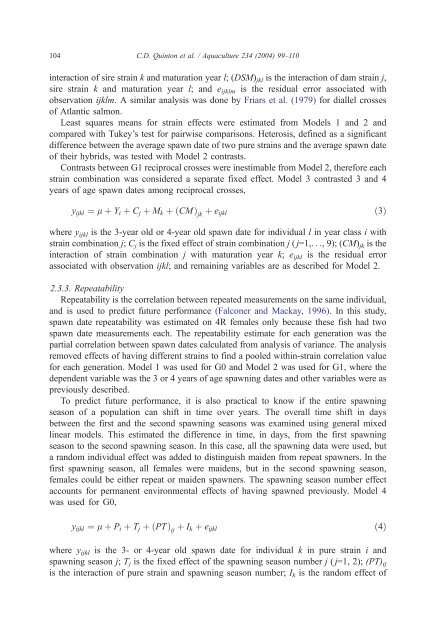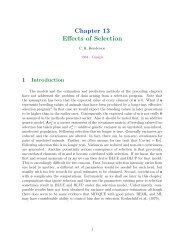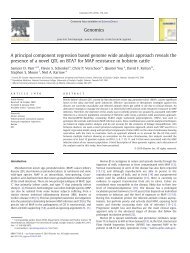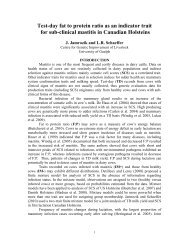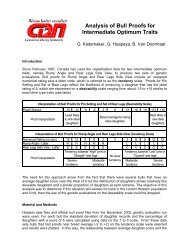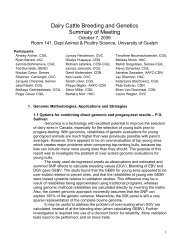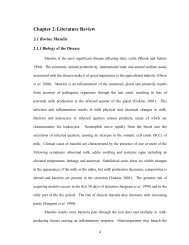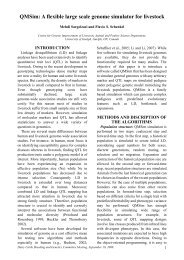Strain and maturation effects on female spawning time in diallel ...
Strain and maturation effects on female spawning time in diallel ...
Strain and maturation effects on female spawning time in diallel ...
You also want an ePaper? Increase the reach of your titles
YUMPU automatically turns print PDFs into web optimized ePapers that Google loves.
104<br />
C.D. Qu<strong>in</strong>t<strong>on</strong> et al. / Aquaculture 234 (2004) 99–110<br />
<strong>in</strong>teracti<strong>on</strong> of sire stra<strong>in</strong> k <str<strong>on</strong>g>and</str<strong>on</strong>g> <str<strong>on</strong>g>maturati<strong>on</strong></str<strong>on</strong>g> year l; (DSM) jkl is the <strong>in</strong>teracti<strong>on</strong> of dam stra<strong>in</strong> j,<br />
sire stra<strong>in</strong> k <str<strong>on</strong>g>and</str<strong>on</strong>g> <str<strong>on</strong>g>maturati<strong>on</strong></str<strong>on</strong>g> year l; <str<strong>on</strong>g>and</str<strong>on</strong>g> eijklm is the residual error associated with<br />
observati<strong>on</strong> ijklm. A similar analysis was d<strong>on</strong>e by Friars et al. (1979) for <strong>diallel</strong> crosses<br />
of Atlantic salm<strong>on</strong>.<br />
Least squares means for stra<strong>in</strong> <str<strong>on</strong>g>effects</str<strong>on</strong>g> were estimated from Models 1 <str<strong>on</strong>g>and</str<strong>on</strong>g> 2 <str<strong>on</strong>g>and</str<strong>on</strong>g><br />
compared with Tukey’s test for pairwise comparis<strong>on</strong>s. Heterosis, def<strong>in</strong>ed as a significant<br />
difference between the average spawn date of two pure stra<strong>in</strong>s <str<strong>on</strong>g>and</str<strong>on</strong>g> the average spawn date<br />
of their hybrids, was tested with Model 2 c<strong>on</strong>trasts.<br />
C<strong>on</strong>trasts between G1 reciprocal crosses were <strong>in</strong>estimable from Model 2, therefore each<br />
stra<strong>in</strong> comb<strong>in</strong>ati<strong>on</strong> was c<strong>on</strong>sidered a separate fixed effect. Model 3 c<strong>on</strong>trasted 3 <str<strong>on</strong>g>and</str<strong>on</strong>g> 4<br />
years of age spawn dates am<strong>on</strong>g reciprocal crosses,<br />
yijkl ¼ l þ Yi þ Cj þ Mk þðCMÞ jk þ eijkl<br />
where y ijkl is the 3-year old or 4-year old spawn date for <strong>in</strong>dividual l <strong>in</strong> year class i with<br />
stra<strong>in</strong> comb<strong>in</strong>ati<strong>on</strong> j; C j is the fixed effect of stra<strong>in</strong> comb<strong>in</strong>ati<strong>on</strong> j ( j=1,..., 9); (CM) jk is the<br />
<strong>in</strong>teracti<strong>on</strong> of stra<strong>in</strong> comb<strong>in</strong>ati<strong>on</strong> j with <str<strong>on</strong>g>maturati<strong>on</strong></str<strong>on</strong>g> year k; e ijkl is the residual error<br />
associated with observati<strong>on</strong> ijkl; <str<strong>on</strong>g>and</str<strong>on</strong>g> rema<strong>in</strong><strong>in</strong>g variables are as described for Model 2.<br />
2.3.3. Repeatability<br />
Repeatability is the correlati<strong>on</strong> between repeated measurements <strong>on</strong> the same <strong>in</strong>dividual,<br />
<str<strong>on</strong>g>and</str<strong>on</strong>g> is used to predict future performance (Falc<strong>on</strong>er <str<strong>on</strong>g>and</str<strong>on</strong>g> Mackay, 1996). In this study,<br />
spawn date repeatability was estimated <strong>on</strong> 4R <strong>female</strong>s <strong>on</strong>ly because these fish had two<br />
spawn date measurements each. The repeatability estimate for each generati<strong>on</strong> was the<br />
partial correlati<strong>on</strong> between spawn dates calculated from analysis of variance. The analysis<br />
removed <str<strong>on</strong>g>effects</str<strong>on</strong>g> of hav<strong>in</strong>g different stra<strong>in</strong>s to f<strong>in</strong>d a pooled with<strong>in</strong>-stra<strong>in</strong> correlati<strong>on</strong> value<br />
for each generati<strong>on</strong>. Model 1 was used for G0 <str<strong>on</strong>g>and</str<strong>on</strong>g> Model 2 was used for G1, where the<br />
dependent variable was the 3 or 4 years of age <strong>spawn<strong>in</strong>g</strong> dates <str<strong>on</strong>g>and</str<strong>on</strong>g> other variables were as<br />
previously described.<br />
To predict future performance, it is also practical to know if the entire <strong>spawn<strong>in</strong>g</strong><br />
seas<strong>on</strong> of a populati<strong>on</strong> can shift <strong>in</strong> <strong>time</strong> over years. The overall <strong>time</strong> shift <strong>in</strong> days<br />
between the first <str<strong>on</strong>g>and</str<strong>on</strong>g> the sec<strong>on</strong>d <strong>spawn<strong>in</strong>g</strong> seas<strong>on</strong>s was exam<strong>in</strong>ed us<strong>in</strong>g general mixed<br />
l<strong>in</strong>ear models. This estimated the difference <strong>in</strong> <strong>time</strong>, <strong>in</strong> days, from the first <strong>spawn<strong>in</strong>g</strong><br />
seas<strong>on</strong> to the sec<strong>on</strong>d <strong>spawn<strong>in</strong>g</strong> seas<strong>on</strong>. In this case, all the <strong>spawn<strong>in</strong>g</strong> data were used, but<br />
a r<str<strong>on</strong>g>and</str<strong>on</strong>g>om <strong>in</strong>dividual effect was added to dist<strong>in</strong>guish maiden from repeat spawners. In the<br />
first <strong>spawn<strong>in</strong>g</strong> seas<strong>on</strong>, all <strong>female</strong>s were maidens, but <strong>in</strong> the sec<strong>on</strong>d <strong>spawn<strong>in</strong>g</strong> seas<strong>on</strong>,<br />
<strong>female</strong>s could be either repeat or maiden spawners. The <strong>spawn<strong>in</strong>g</strong> seas<strong>on</strong> number effect<br />
accounts for permanent envir<strong>on</strong>mental <str<strong>on</strong>g>effects</str<strong>on</strong>g> of hav<strong>in</strong>g spawned previously. Model 4<br />
was used for G0,<br />
yijkl ¼ l þ Pi þ Tj þðPTÞ ij þ Ik þ eijkl<br />
where yijkl is the 3- or 4-year old spawn date for <strong>in</strong>dividual k <strong>in</strong> pure stra<strong>in</strong> i <str<strong>on</strong>g>and</str<strong>on</strong>g><br />
<strong>spawn<strong>in</strong>g</strong> seas<strong>on</strong> j; Tj is the fixed effect of the <strong>spawn<strong>in</strong>g</strong> seas<strong>on</strong> number j ( j=1, 2); (PT)ij<br />
is the <strong>in</strong>teracti<strong>on</strong> of pure stra<strong>in</strong> <str<strong>on</strong>g>and</str<strong>on</strong>g> <strong>spawn<strong>in</strong>g</strong> seas<strong>on</strong> number; Ik is the r<str<strong>on</strong>g>and</str<strong>on</strong>g>om effect of<br />
ð3Þ<br />
ð4Þ


